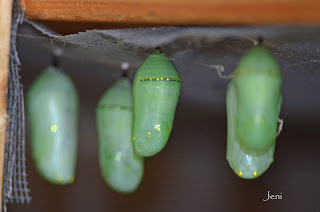This was an exciting find for me ~ and a first!
And so it begins ~
Next ~ the egg hunt
I can't walk by or drive by a milkweed plant without wondering what might be hiding underneath those leaves. Many times, I will stop and check each individual leaf to see what suprizes are hidden. Sometimes I luck out and find a caterpillar, which gives me a better chance of having a butterfly in the end, as many of the eggs never hatch.
The caterpillars start out very tiny (about 1mm) ~ someday I will get a good, clear photo. I actually was able to watch a little caterpillar crawl out of it's egg just yesterday for the first time. They eat part of the egg shortly after hatching and then start munching on the milkweed leaf.
After about a week and a half, the caterpillar is now large (about 2.5") and ready to make it's chrysalis. I have witnessed this many times now and still am amazed at the process. The final result is as beautiful as a jewel.
Shortly before it's ready to hatch, the chrysalis looks dark.
You can see the monarchs wings through the clear shell of the chrysalis.
Usually within 24 hours, the butterfly will emerge.
The monarch emerges with it's wings all crinkled up and pumps fluid from it's abdomen into it's wings to inflate them. It will then hang for several hours, allowing it's wings to dry out for flight.
Once it is ready to go, I place a tag on it's wing and release it into my garden. Sometimes it will hang around for awhile, other times it will take flight immediately towards the tree tops to rest.
I get my tags from the "Monarch Watch" out of Kansas City University. The tag has a phone number and a "tag" number on them. The tags come with a log sheet that is sent back to Monarch Watch, where the information is loaded into a database.
The form asks for the date the monarch hatched, the tag #, the sex, whether it was reared or tag in the wild, and where it was released.
This was a lucky shot taken as the female monarch took flight.
You can see the tag through her wing if you look closely.
This chrysalis was very small ~ only about 2/3 the normal size.
I didn't think it was going to make it, but it finally hatched.
When it did, he was much smaller than the other ones that had hatched.
It also had a crinkled up left hind-wing and it's left antenna was only half the normal size.
Unfortunately, "Flutter" as I named him, won't be making the trip to Mexico, since he can't fly.
I will take care of him for as long as he lives. Last year , I had two hatch with defective wings and took care of them until they died around Thanksgiving. I fed them fresh fruit, applesauce, and a honey/water mix on a sponge once all the flowers stopped blooming.
Flutter has already been feeding on butterfly bush blossoms.
This next photo captures the tail end of a caterpillar shedding it's skin.
This female hatched today. Her front wings seem a little darker than normal ~ but she is very beautiful. She hung out on the sedum for an hour or so before flying off.






















































